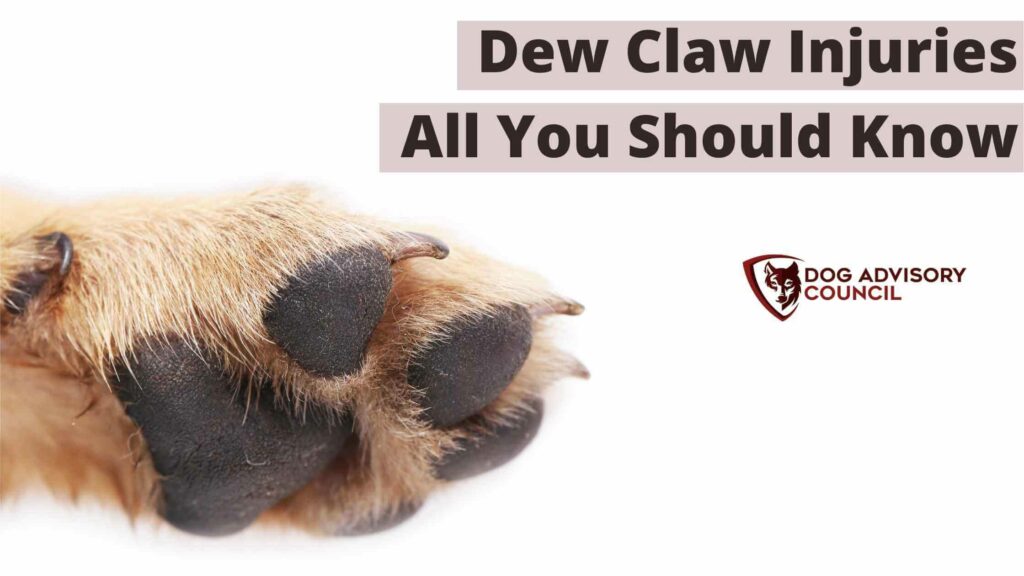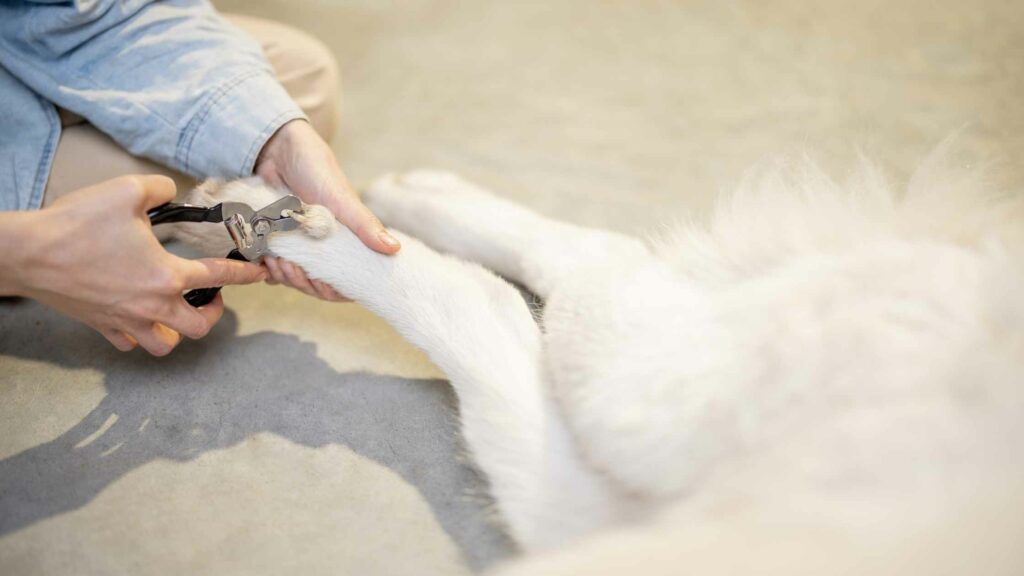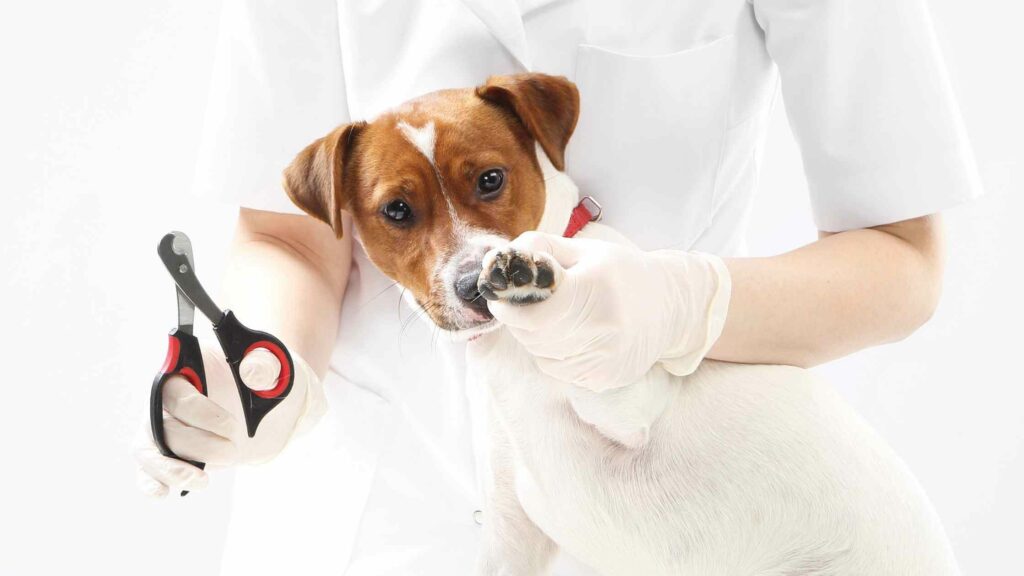
Does your dog’s dew claw seem to be giving your dog some issues? It’s more common than you’d think! Here’s what you should know about dew claw injuries and what you can do about them!
Your dog’s dew claw can become injured easily by becoming ingrown, torn, broken, or infected. An injured dew claw injury can cause limping, bleeding, licking, swelling, and discomfort in the area being touched. Like any signs of pain, you should take these seriously and take your dog to the vet to see what’s going on.
How serious is a dew claw injury?
A dew claw injury can range from mild to potentially fatal, depending on what happens to it and how long it’s left untreated. A torn nail can get infected and turn a mild injury into potentially life-threatening sepsis if it goes undetected.
Even if an injury to your dog’s dew claw seems mild, a call to the vet and a trip in to have it checked are both recommended to spot a minor problem before it becomes a major one.
Common dog dew claw injuries
How can your dog hurt this highly-placed dew claw, anyway? Common injury causes include:
- Having an ingrown or overgrown nail
- Tearing it during play or running
- Getting an infection in the nail
All of these are normal parts of dog-related life, but you’ll want to pay special attention to treating an injured dew claw as soon as you notice something out of the ordinary about it.
Is a torn dew claw an emergency?
The urgency status for your dog’s dew claw will depend mostly on what happened to the claw itself.
In the case of a broken nail, you can wait until the next available appointment. You’ll want to get your dog in to ensure there is no infection or further injury, but it’s not an emergency. If you’re dealing instead with an infection or perhaps a broken or dislocated dew claw. In that case, you’ll want to get him in sooner rather than later to see what’s going on and how to best approach it.
When it comes to a break of the bone or dislocation or even an infection, treating it properly and correctly for your dog’s health and the benefit of your pocketbook as much as possible!
Regardless of what has happened, your dog’s dew claw will need vet care sooner rather than later, so it’s best to look at booking a vet appointment as soon as you notice the injury to the claw.
Signs of an injured dew claw
There is any number of signs that your dog’s dew claw is giving them problems, and the most common ones to look for include:
- Limping
- Licking at the area
- Swelling of the dew claw
- Blood
- Puss
- A strange smell
The more that you notice these problems, the more severe your dog’s health situation might be.

How to tell if the dew claw is dislocated
If your dog has gotten a little rough while playing, they could have dislocated their dew claw. You’ll know this is the case if you notice a lot of limping, swelling around the claw, and excessive licking. You’ll also notice that the claw and its toe seem at a strange angle. Try to get your dog to a vet quickly to help reset it and relieve your dog’s pain.
How long does a dew claw injury take to heal?
The healing process of this important toe is going to be relatively quick in most cases! If it’s a torn nail or an infected nail, it can take a week or perhaps some 2 weeks. A dislocated toe will take about a week. A broken toe can take several weeks to a month.
As you might be able to guess, the sooner you get your dog looked at and treated, the faster the recovery will be. A mild infection is faster to treat than a severe one, after all!
Will my dog’s dew claw heal on its own?
In mild cases, your vet may just send your dog home with a few DIY instructions for care. In this case, you can rest assured that your dog’s dew claw will heal on its own. A torn nail, for instance, just needs to be cleaned and left to heal on its own, on disturbed.
Going to the vet is important to get a proper diagnosis of what’s going on with your dog’s dew claw, so don’t assume that you can care for it safely if you haven’t had it looked at!
The most important thing with a dew claw injury and its recovery is to keel to clean and undisturbed from your dog picking at it! Your dog’s body can repair itself pretty easily and quickly!
How do you treat a torn dew claw on a dog?
As mentioned above, you’ll simply keep it clean and cover the dew claw as it heals from the tear. If you do this properly, it’ll heal in no time, and you won’t need to worry about the possible complication of an infection. An infection will require antibiotics and follow-up care, so pay careful attention to this!
How do you fix a broken dew claw at home?
If your dog’s dew claw appears broken, you’ll want to take it to the vet to guarantee that it’s the claw that’s broken rather than the bone of the toe itself.
A broken nail can receive the same treatment as a torn one. Clean and cover it to allow the nail to grow as normal. If your dog doesn’t stop picking at it, you’ll want to consider a better bandage or perhaps a cone. The healing process will be easier if your dog leaves it alone!
If the bone itself is broken, your vet will treat it by stabilizing it so that the toe can heal properly. Dogs heal quickly, so it won’t be long until they return to their normal self!
Should you cut a dog’s dew claw?
It’s normal dog health care to trim your dog’s dew claw just like any other nail on their paws. This trimming helps them to keep it from getting broken or overgrown, which can lead to an ingrown nail and an infection. An ingrown dew claw can be very painful for your dog, too.
Some feel as though a dew claw should be removed since it doesn’t really serve a purpose to your dog’s anatomy. However, most disagree with this. The dew claw is important to your dog’s foot since it stabilizes them and offers them the equivalent of opposable thumbs.
A vet will sometimes surgically remove the claw of the dew claw, but this is done mostly with polydactyl dogs or in situations where they are dealing with a constant ingrown nail. Your vet will always do what they can to minimize the need to remove the nail itself. If they decide to remove it, you’ll know it’s in your dog’s best interests!

Home remedies for an infected dew claw
If you are dealing with an infected dew claw, you will want to have your vet take a look at it. While you can care for it at home using a few DIY remedies (more on that next), you should strongly consider the antibiotics since an infected dew claw can be fatal if it gets so severe as to cause sepsis.
If the infection is mild and your vet is okay with at-home treatment, or you just decide that you want to go all-natural, then there are a few at-home options.
The best one is going to be warm water and a bit of mild dog-safe soap or cleanser. Wash your dog’s claw area thoroughly and dry it entirely. This keeps the area clean, so you can expose the infection and kill it. This should be done several times a day, particularly when they come in from outside or anywhere else that they may have picked up debris and bacteria.
You can also try warm water and salt since salt can help speed up this process. You’ll need to take care not to let your dog lick their feet, though, since the salt needs to work into the claw to do its job.
Unless your vet says otherwise, you’ll want to bandage the claw with both techniques.
Should I bandage a dew claw?
You’ll want to keep the claw covered, as mentioned above. This allows the claw and the general area to heal without your dog picking at it. Their instinct is to lick at an injury, and they’ll be persistent in doing this.
If you can’t cover it properly, or keep it covered, try a bitter-tasting vet-approved spray to deter them. Or, put a dollar on your dog so they can’t access their paw while it recovers.
How do you wrap a broken dog’s dew claw?
If the claw is broken, wrapping is even more important to protect the sensitive quick and help the nail beds grow out a new nail quickly and easily. To wrap the nail properly, ask your vet to show you how tight to wrap and even how much of your dog’s foot to wrap. Try doing it yourself at the vet’s office to ensure you know how to do it.
Keep in mind that a broken nail is different from a broken bone. If the bone is broken, your vet most likely will put it in a traditional cast so that it can heal properly as a normal broken bone would. Don’t try to do this yourself, as a broken bone must be stabilized and reset to heal properly!
How much does a dew claw injury cost?
The cost at your vet’s office will depend mostly on the injury’s severity. Treatment could be as simple as a consult at the vet to something as costly as anesthesia. The price could be anywhere from $20-$100, accordingly!
How to prevent dog’s dew claw injuries
If you want to help your dog avoid the need for a vet visit, there are a few things that you can do to help your dog’s dew claw stay as healthy as possible,
Firstly, keep your dog’s nails trimmed, including their dew claw. The better cared-for those nails are, the less likely that they’ll get snagged on something or will cause an infection, etc. Prevention is always your best approach!
The other thing to consider is being careful with your dog is roughhousing or running around. While it’s unreasonable to expect your dog never to run around, pay attention to their movements during and after their exercise so that you can spot any injuries to the dew claw as soon as they happen. The sooner they are, the better the treatment options.
In brief
A dew claw injury is much more common than most people think, and it needs to be cared for as quickly as possible for your dog’s comfort and overall quality of life. A dog’s dew claw can get injured from playing or running around. Common injuries include infection from an ingrown claw, a broken or dislocated dew claw, or a broken nail.
Symptoms of an injury include limping, swelling around the claw, licking at the claw, and obvious discomfort with their paw being handled. You’ll want to get your dog to a vet quickly to help determine the injury and the best way to deal with it!
Do you know someone trying to decide how to take care of their dog’s injury in this area? Share this with them and help!
